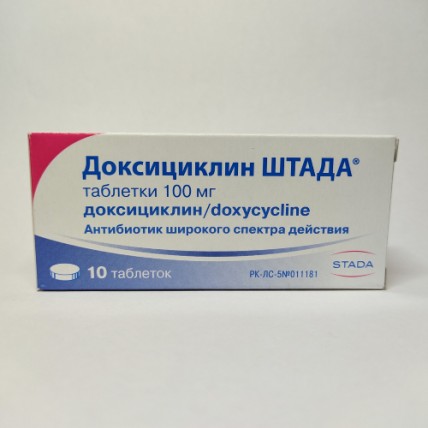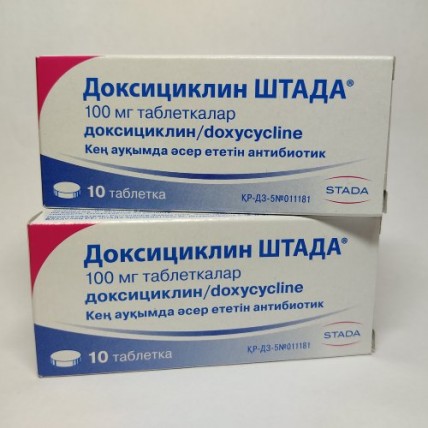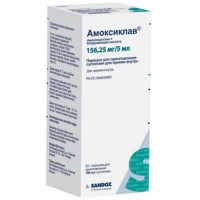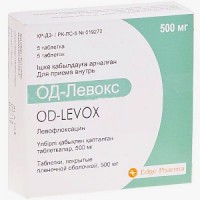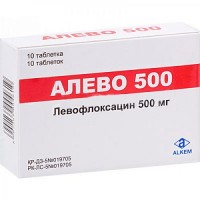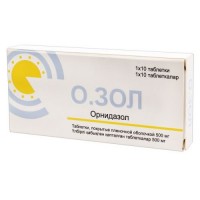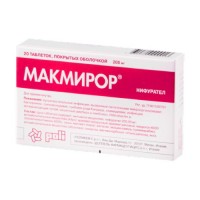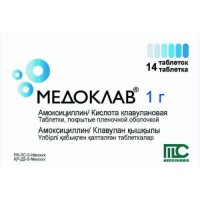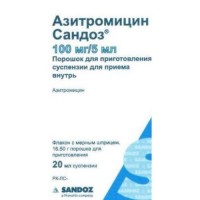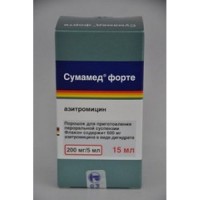Doxycycline STADA 100 mg (10 tablets)
- $10.50
Out Of Stock
Doxycycline is an antibiotic. It's used to treat infections such as chest infections, skin infections, rosacea, dental infections and sexually transmitted infections (STIs), as well as a lot of other rare infections. It can also be used to prevent malaria if you're travelling abroad.
Common brand names: Acticlate, Doryx, Doryx MPC, Oracea, Adoxa, Adoxa Pak, Alodox, Avidoxy, Doxal, Doxy 100, LYMEPAK, Mondoxyne NL, Monodox, Morgidox 1x, Morgidox 1x Kit, Morgidox 2x, Morgidox 2x Kit, NutriDox, Ocudox, Oracea, Oraxyl, Periostat, TARGADOX, Vibra-Tabs, Vibramycin
Structure
One tablet contains the active substance - doxycycline monohydrate 104.1 mg or 208.2 mg (equivalent to 100 mg or 200 mg of doxycycline, respectively),
excipients: microcrystalline cellulose, sodium starch glycolate (type A), magnesium stearate.
Indications for use
Infections caused by microorganisms sensitive to doxycycline:
- chronic bronchitis in the acute stage, sinusitis, otitis media, pneumonia caused by mycoplasmas, rickettsiae or chlamydia
- urethritis caused by chlamydia and Ureaplasma urealyticum, acute prostatitis, uncomplicated gonorrhea (especially with simultaneous infection with chlamydia), infections of the female genital organs, syphilis with allergy to penicillins, urinary tract infections (only with proven sensitivity of pathogens)
- cholera, infections caused by Yersinia, Campylobacter, Shigella, with proven sensitivity
- biliary tract infections
- chlamydial conjunctivitis and trachoma
- borreliosis (chronic erythema migrans or Lyme disease)
- rare infections (brucellosis, psittacosis, bartonellosis, listeriosis, rickettsiosis, melioidosis, plague, inguinal granuloma)
- malabsorption syndrome (tropical Sprue and Whipple's disease)
| Spectrum of action of tetracyclines | |
| Gram-positive pathogens | Gram-negative pathogens |
| Staphylococci | Bartonella species |
| Borrelia burgdorferi | |
| Burkholderia pseudomallei | |
| Streptococci of various serological groups | Brucellaceae |
| Bacteroides (some species) | |
| Corynebacterium | Calymmatobacterium granulomatis |
| Listeria monocytogenes | Campylobacter species |
| Clostridia (excluding C. difficile) | Fusobacteria |
| Propionibacterium acnes | Neisseria gonorrhoeae |
| Tropheryma whippelii | Many Enterobacteriaceae (e.g. E. coli, Citrobacter species, Klebsiella, Morganella morganii, Salmonella, Shigella, Yersinia) |
| Haemophilus influenzae | |
| Pasteurella multocida | |
| Treponema pallidum | |
| Vibrio cholerae | |
| Chlamydia species | |
| Mycoplasma species | |
| Ureaplasma urealyticum | |
| Rickettsia | |
| Streptococci of groups A and B, Bacteroides fragilis, E. coli, Citrobacter species, enterococci, gonococci, N. influenzae, Morganella morganii, pneumococci, staphylococci, Shigella spp. may have secondary (acquired) resistance to doxycycline. Enterobacter aerogenes, Providencia species, Proteus spp., Serratia spp., Pseudomonas are primarily resistant to doxycycline. | |
| Complete cross-resistance exists within the tetracyclines group. | |
Method of administration and dosage
Adults weighing 50 kg - 70 kg, adolescents and children over 8 years old on the 1st day take 200 mg of doxycycline, and on the following days - 100 mg of doxycycline.
For severe illnesses or patients weighing over 70 kg, 200 mg of doxycycline is prescribed daily throughout the course of treatment.
The dosage for children over 8 years old (weighing less than 50 kg) is 4 mg / kg of body weight in 1 dose on the first day, which corresponds to 100-200 mg of doxycycline, and 2 mg / kg of body weight in 1 dose, which corresponds to 50 -100 mg doxycycline on the following days. Since the tablets of Doxycycline STADA® 100 mg and 200 mg are indivisible, it may be difficult to properly dose the drug in this group of patients.
The duration of therapy depends on the course of the disease and is prescribed by the doctor. The average duration of therapy is 5-21 days.
In the treatment of bacteriologically confirmed β-hemolytic streptococcus infection with doxycycline, the duration of treatment is at least 10 days to prevent late complications such as rheumatic fever or glomerulonephritis.
Special dosage recommendations
Acute gonorrheal urethritis in men and acute gonococcal infections in women - 200 mg of doxycycline per day for 7 days.
Acute gonococcal epididymitis - 200 mg of doxycycline per day for 10 days.
The success of treatment for gonococcal infection should be checked 3-4 days after the end of therapy.
Syphilis (primary and secondary form for allergy to penicillins) - 300 mg of doxycycline per day (can be taken at a time), the duration of treatment is 10 days.
Lyme disease (stage I) - 200 mg of doxycycline for 14 days.
Mode of application
Doxycycline STADA® tablets are taken regularly during meals with plenty of liquid (but not milk). Taking the drug with meals reduces the incidence of side effects from the gastrointestinal tract and, only to a small extent, affects the absorption of doxycycline. In addition, before taking the tablets, you can dissolve them (by stirring) in a glass of water. The solution should be drunk completely.
Side effects
Often (> 1/100 to <1/10)
- nausea, heartburn, feeling of pressure in the stomach, the urge to vomit, vomiting, flatulence, steatorrhea, diarrhea
Uncommon (> 1 / 1,000 to <1/100)
- pharyngitis, hoarseness, difficulty swallowing, melanoglossia
- phototoxic reactions - with sun exposure of the skin: redness, swelling, blistering, discoloration of the skin,
- allergic reactions, generalized exanthema, erythema, urticaria, pruritus, exudative erythema multiforme, reversible local swelling of the skin, mucous membranes or joints (angioedema), asthma, anaphylactic shock, persistent drug rash on the genitals and other parts of the body, reaction, serum sickness-like accompanied by fever, headaches, and joint pain
- blood clotting disorders and hematuria
- candidiasis of the skin and mucous membranes (especially of the genitals and mucous membranes of the mouth and intestines), accompanied by symptoms such as inflammation of the mucous membrane of the mouth and pharynx (stomatitis, glossitis), acute inflammation of the external genital organs and vagina in women (vulvovaginitis), and itching in the anal area (Pruritus ani)
Rarely (> 1 / 10,000 to <1/1000)
- increased intracranial pressure, manifested in the form of headaches, nausea, vomiting and visual impairment due to edema of the optic nerve head
- phototoxic reactions with changes on the part of the nails - separation of the nail from the nail bed and discoloration of the nail plate
- leukopenia, leukocytosis, thrombocytopenia, anemia, lymphocytopenia, lymphadenopathy, atypical lymphocytes and toxic granulocyte granulation
- liver damage, pancreatitis
- nephrotoxic lesions, exacerbation of existing renal dysfunctions, interstitial nephritis, acute renal failure, anuria
- severe acute symptoms of hypersensitivity, such as swelling of the face, swelling of the tongue, internal laryngeal edema with narrowing of the airways, heart palpitations, dyspnea (shortness of breath), drop in blood pressure up to shock and cardiac arrest
- exfoliative dermatitis, Lyell's syndrome
- paresthesia, tachycardia, myalgia, arthralgia, anxiety, state of fear
- violation or loss of olfactory and gustatory sensation
Very rare (<1 / 10,000)
- pseudomembranous enterocolitis
- myopia, myopia
- epileptic seizures
Contraindications
- hypersensitivity to tetracyclines or other component of the drug
- severe liver dysfunction
- children's age up to 8 years (because before the end of the teething phase, due to the deposition of calcium orthophosphate complexes, irreversible discoloration of the teeth and the appearance of defects in tooth enamel, as well as a slowdown in bone growth, may occur)
- pregnancy and lactation
Drug interactions
The absorption of doxycycline from the gastrointestinal tract is reduced under the influence of 2- or 3-valent cations of aluminum, calcium (milk, dairy products and calcium-containing fruit juices) and magnesium, which are part of antacids, as well as under the influence of iron preparations, activated carbon and cholestyramine... Therefore, medicines or food products containing these cations should be taken at intervals of 2-3 hours relative to the time of taking doxycycline.
Rifampicin, barbiturates, anticonvulsants (carbamazepine, diphenylhydantoin and primidone), as well as chronic alcohol abuse, due to the induction of enzymes in the liver, accelerate the metabolism of doxycycline. As a result, the therapeutically effective blood concentrations of doxycycline cannot be achieved with the usual doses of the drug.
Doxycycline enhances the action of sulfonylureas (oral antidiabetic agents) and anticoagulants such as dicumarol. With combined use, it is necessary to monitor blood sugar levels and blood coagulation parameters and, if necessary, reduce the dose of the above drugs.
With the simultaneous use of doxycycline and cyclosporin A, the toxic effect of the immunosuppressant increases.
Doxycycline therapy in combination with methoxyflurane anesthesia can lead to renal failure.
Before starting treatment, during it, and immediately after treatment with isotretinoin for acne, you should refrain from therapy with doxycycline, since both drugs can cause an increase in intracranial pressure.
The simultaneous administration of doxycycline and beta-lactam antibiotics should be avoided, as this leads to a decrease in antibacterial effectiveness.
With the simultaneous use of theophylline and tetracyclines, the likelihood of side effects from the gastrointestinal tract increases.
Special instructions
Patients with impaired renal function do not need to reduce the dose of doxycycline.
With prolonged use, it is necessary to regularly conduct blood tests, liver and kidney function.
During treatment with doxycycline, sunbathing in the open air or in solariums should be avoided, due to the possibility of phototoxic reactions.
It should be borne in mind that due to the intake of antibiotics of the tetracyclines group, the determination of the level of sugar, protein, urobilinogen and catecholamines in the urine may be inaccurate.
With doxycycline therapy, the reliability of the contraceptive action of hormonal contraceptives may be questioned. Therefore, it is recommended to additionally use non-hormonal contraceptives.
In the case of the development of pseudomembranous colitis, depending on the severity of the underlying disease, a decision should be made to discontinue therapy with STADA® Doxycycline, and if necessary, appropriate treatment should be carried out (taking specific antibiotics and chemotherapeutic agents, the effectiveness of which has been clinically proven) without discontinuing the drug.
Application in children
For children over 8 years old, doxycycline is prescribed only for the treatment of diseases that pose a threat to the child's life and only after a careful assessment of the potential benefits and possible risks.
Features of the effect of the drug on the ability to drive a vehicle or potentially dangerous mechanisms
Given that in some cases, when taking tetracyclines, the development of transient myopia (myopia) has been reported, caution should be exercised when driving a car and servicing potentially dangerous mechanisms.
Overdose
Symptoms: Acute intoxication with doxycycline has not yet been described in the literature. However, in case of overdose, there is a danger of parenchymal lesions of the liver and kidneys, as well as pancreatitis.
Treatment: In case of an oral overdose of doxycycline, the still unabsorbed substance should be bound into non-absorbable chelate complexes by taking antacids or calcium and magnesium salts. Treatment with the drug should be discontinued immediately. Symptomatic treatment is carried out. Hemodialysis or peritoneal dialysis is ineffective.
Storage conditions
Store at a temperature not exceeding 25 ° C.
Keep out of the reach of children!
Shelf life - 5 years
Do not use after the expiration date.
